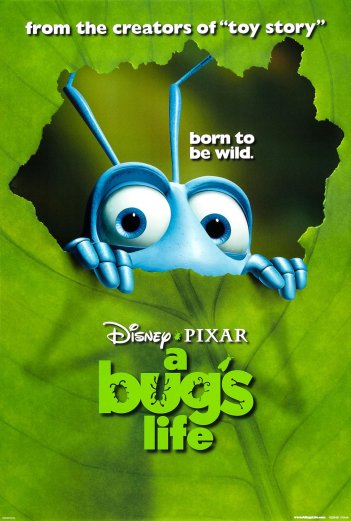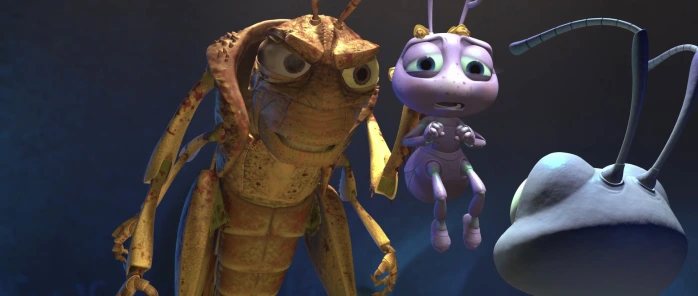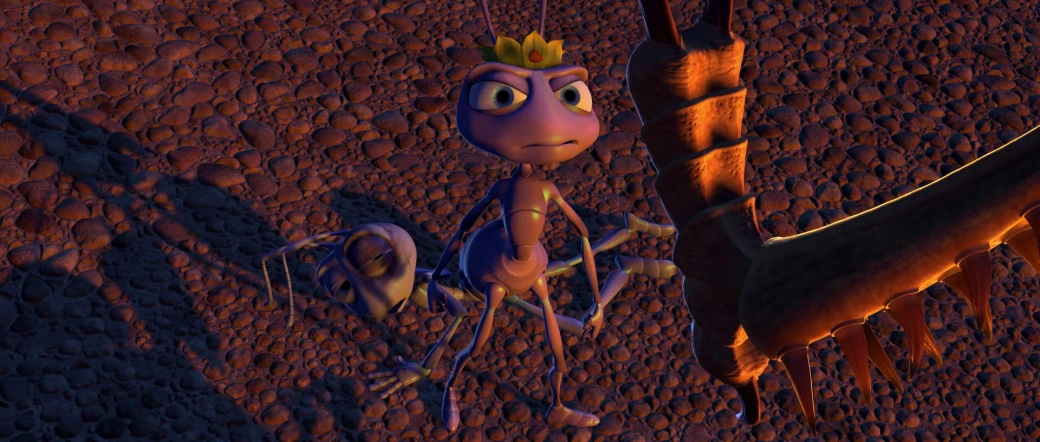* contains spoilers *
 Even though A Bug’s Life is the second movie in the Pixar filmography, this is my first post for “Watch-It Wednesdays,” my weekly movie night with friends. Going into this film, I remembered it fondly. I never did see it in cinemas, even though I had loved the trailer (still do, this one too).
Even though A Bug’s Life is the second movie in the Pixar filmography, this is my first post for “Watch-It Wednesdays,” my weekly movie night with friends. Going into this film, I remembered it fondly. I never did see it in cinemas, even though I had loved the trailer (still do, this one too).
However, I was put off by public reception and by my own rather less than fond reaction to Dreamworks’ ANTZ. I will try not to compare the two films in this review as they really aren’t anything alike (aside from featuring insect characters) and they offer radically different viewing experiences. To this day, though, I prefer A Bug’s Life.
According to the Disney Wiki: “The film is loosely inspired by the fable ‘The Ant and the Grasshopper’ and the classic film The Seven Samurai, it is the second Pixar movie and tells the story of an outcast inventor ant named Flik, who recruits a group of circus bugs he mistakes for warriors when his colony is threatened by a group of grasshoppers.”
Back in 1998, I remember a general consensus of disappointment with this film as a follow-up to Pixar’s first feature, but I find that, the further away we get from initial release, the better A Bug’s Life holds up.
The animation is still gorgeous – and QUITE a step up from Toy Story, particularly in scope, scale, and space. I’ve said it before; animation is so often underrated when it comes to cinematography. The camera (albeit a computer-generated one) is so effective, leveling up from it’s predecessor with depth and focal length. The perspective is widened, allowing the naturalistic elements to shine. Both A Bug’s Life and ANTZ fall prey to the early limitations of CG Animation, but Pixar utilizes color and light brilliantly, filling the frame with textured rays or showering the characters and backgrounds with dappled, dramatic spots. This leads to real visual spectacle and a much more thorough atmosphere.
This isn’t to say that Bug’s Life is always cheerful; far from it. I found the story extremely poignant this go-round, with the theme of oppression demonstrated with surprising effectiveness, especially for a kids’ movie. For example, I was struck by the way in which rebellion builds through the film, with a delightful “three-beat” at play. The first real demonstration of resilience appears when the villain, Hopper, puts young Princess Dot in apparent danger and Flik jumps out of the crowd: “Leave her alone!” he shouts.
And this was something else I noticed about Flik on this rewatch; while he has a lot of big ideas, he is also impulsive; quick to act in an emergency and find spontaneous solutions. It’s a huge virtue that the film never totally recognizes. To me, it’s of equal importance to his big-picture ideas.)

“You want her? Go ahead. Take her.”
Anyhow, at first, Hopper is taken aback by someone daring to interrupt his display of power, but he quickly channels his surprise and outrage into calling Flik’s bluff. He dares Flik to follow through with the challenge and this puts both Dot and Flik in even further danger. Flik, antennae drooping, stoops and backs away, merging, once again, into the silent crowd. I really appreciated this as an adult. It resonated with me in a new way; as what can happen when we see injustice and don’t know how to fight it. . . or we are too inhibited by fear. We know Flik is a caring soul and truly means well – he is easily the most rash character on Ant Island – but even he cannot challenge Hopper’s authority. Not on his own. He is not powerful enough and, as a result, can only fall back in line.
It’s not a surprise, however, that Hopper pivots here, from the display of power over one individual ant. Hopper must scare any whisper of defiance back out of the whole colony. “Let’s double the order of food.” He must ensure that the crowd understands the exchange that just took place; why Flik was right to back away.
The next beat of Flik’s resistance comes towards the end, just after Operation Fake Bird fails. This time, he takes responsibility for the act of rebellion. He even uses the same phrase, which I’d never noticed before – “Leave her alone, Hopper!” – this time coming to the aid of Princess Atta as she, in turn, shields the children. This time, when Flik emerges, he does not just call out on instinctive impulse, but deliberately stands firm and continues, voice loud and strong: “The bird was my idea. I’m the one you want.” Still, he gets struck down and nearly overtaken.
I hadn’t considered until this rewatch that, even if Operation Fake Bird succeeded…was it really a long-term solution? It might scare the grasshoppers away, but wouldn’t they just return the following season? The battle is not won. The resistance to oppression is neither open or complete. Only when Flik rises up the third time, calling on the strength of the whole colony (rather than just his own), are the grasshoppers finally beaten.
“Ants are not meant to serve Grasshoppers. I’ve seen these ants do great things. And year after year they somehow manage to pick food for themselves and you . . . We’re a lot stronger than you say we are. And you know it, don’t you?”
He is nearly – literally – crushed, until Princess Atta comes to his rescue, marking a shift in the colony’s collective consciousness. She, too, plays out a three-beat through the film; first, buckling under the pressure at the beginning, then, second, protecting the girls, a tremor of fear in her voice (“just get behind me, girls, it’ll be okay”) and then, here. She stands with her shoulders back, confident and defiant, as an able leader.

This, here, is a powerful image.
I know this is all fairly obvious, but the significance and depth was totally lost on me as a kid. I’m thoroughly impressed as an adult and really wish that more folks appreciated this movie.
So, if you haven’t seen it recently, I highly recommend a rewatch. You might be surprised at how much this movie has to offer.
<< Previous: What is ‘Watch-It-Wednesdays‘? | Next: Monsters, Inc. >>
Pingback: Watch-It Wednesdays | Robin C. Farrell
Pingback: Monsters, Inc. | Robin C. Farrell